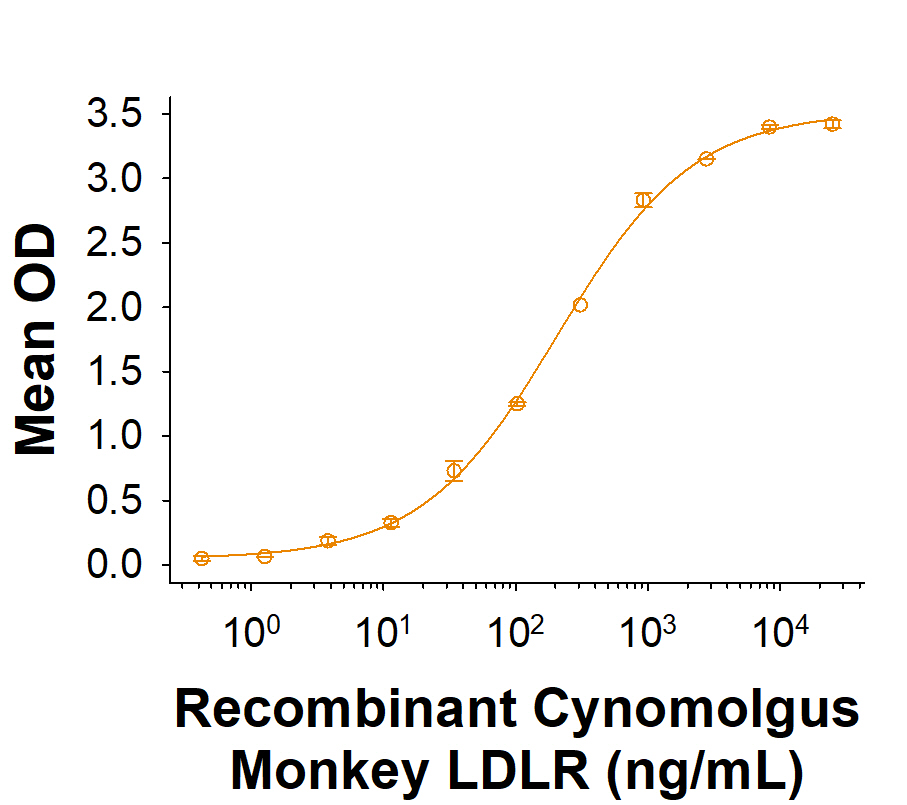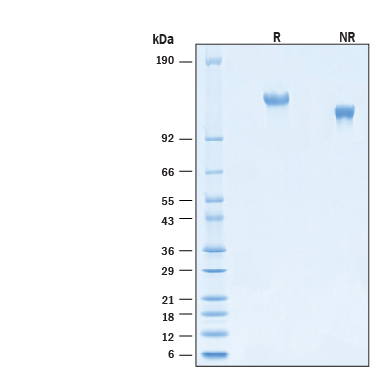Recombinant Cynomolgus Monkey LDLR His-tag Protein, CF Summary
Product Specifications
Ala22-Gly788, with a C-terminal 6-His tag
Analysis
Product Datasheets
Carrier Free
CF stands for Carrier Free (CF). We typically add Bovine Serum Albumin (BSA) as a carrier protein to our recombinant proteins. Adding a carrier protein enhances protein stability, increases shelf-life, and allows the recombinant protein to be stored at a more dilute concentration. The carrier free version does not contain BSA.
In general, we advise purchasing the recombinant protein with BSA for use in cell or tissue culture, or as an ELISA standard. In contrast, the carrier free protein is recommended for applications, in which the presence of BSA could interfere.
11151-LD
| Formulation | Lyophilized from a 0.2 μm filtered solution in PBS with Trehalose. |
| Reconstitution | Reconstitute at 200 μg/mL in PBS. |
| Shipping | The product is shipped at ambient temperature. Upon receipt, store it immediately at the temperature recommended below. |
| Stability & Storage: | Use a manual defrost freezer and avoid repeated freeze-thaw cycles.
|
Scientific Data
 View Larger
View Larger
When Human LDL is immobilized at 4.00 µg/mL (100 µL/well), Recombinant Cynomolgus Monkey LDLR His-tag Protein (Catalog # 11151-LD) binds with an ED50 of 30.0‑300 ng/mL.
 View Larger
View Larger
2 μg/lane of Recombinant Cynomolgus Monkey LDLR His-tag Protein (Catalog # 11151-LD) was resolved with SDS-PAGE under reducing (R) and non-reducing (NR) conditions and visualized by Coomassie® Blue staining, showing bands at 125-140 kDa.
Reconstitution Calculator
Background: LDLR
The low density lipoprotein receptor (LDLR) is the founding member of the LDLR family, a group of widely expressed type I transmembrane glycoprotein cell surface scavenger receptors (1-5). Members of the family are endocytic receptors which bind and internalize extracellular ligands, including lipoproteins, exotoxins, and lipid‑carrier complexes but can also co-regulate adjacent cell-surface signaling molecules (3, 4). Mature LDLR consists of an extracellular domain (ECD) with 7 cysteine‑rich complement-like repeats (class A LDL domains), calcium-binding EGF repeats, and beta ‑propeller structures (class B LDL repeats), a transmembrane domain and a cytoplasmic domain with an NPxY-repeat motif. The ECD of cynomologus LDLR shares 94% amino acid sequence identity with human LDLR. LDLR is constitutively and widely expressed and plays a key role in regulating cholesterol homeostasis. The class A LDL domains near the N-terminus of LDLR bind apoB and apoE, the apolipoproteins of low- and very low-density lipoproteins (LDL and VLDL), respectively (1, 2, 4, 7). Hepatocyte LDLR is responsible for endocytosis and clearing of most plasma LDL cholesterol from circulation (2, 7). At the low pH of the endocytic vesicle, it dissociates, allowing degradation of LDL and recycling of LDLR to the cell surface (1, 4). Lack of LDLR expression or function causes familial hypercholesterolemia (FH) and leads to premature cardiovascular disease (4, 7, 8). The protease PCSK9 (proprotein convertase subtilisin/kexin type 9) can also cause increased plasma cholesterol by promoting LDLR degradation rather than recycling to the cell surface (8-10). Additionally, soluble forms of LDLR are reported to be released by phorbol esters or interferons and could serve as a disease marker (5, 11, 12). Several studies have demonstrated a role for LDLR in cancer progression, including liver cancer, leukemia, lung cancer, breast cancer, colorectal cancer, and prostate cancer (13).
- Go, G.W. and A. Mani (2012) Yale J. Biol. Med. 85:19.
- Ren, G. et al. (2010) Proc. Natl. Acad. Sci. USA 107:1059.
- Bujo, H. and Y. Saito (2006) Arterioscler. Thromb. Vasc. Biol. 26:1246.
- Gent, J. and I. Braakman (2004) Cell. Mol. Life Sci. 61:2461.
- Begg, M.J. et al. (2004) Eur. J. Biochem. 271:524.
- Stolt, P.C. and H.H. Bock (2006) Cell. Signal. 18:1560.
- Defesche, J.C. (2004) Semin. Vasc. Med. 4:5.
- De Castro-Oros, I. et al. (2010) Appl. Clin Genet. 3:53.
- Zhang, D.W. et al. (2008) Proc. Natl. Acad. Sci. U.S.A. 105:13045.
- Tavori, H. et al. (2013) Circulation 127:2403.
- Fischer, D.G. et al. (1993) Science 262:250.
- Mbikay, M. et al. (2020) Lipids Health Dis 19:17
- Roslan, Z. et al. (2019) J. Oncol. 2019:536302.
FAQs
No product specific FAQs exist for this product, however you may
View all Proteins and Enzyme FAQsReviews for Recombinant Cynomolgus Monkey LDLR His-tag Protein, CF
There are currently no reviews for this product. Be the first to review Recombinant Cynomolgus Monkey LDLR His-tag Protein, CF and earn rewards!
Have you used Recombinant Cynomolgus Monkey LDLR His-tag Protein, CF?
Submit a review and receive an Amazon gift card.
$25/€18/£15/$25CAN/¥75 Yuan/¥1250 Yen for a review with an image
$10/€7/£6/$10 CAD/¥70 Yuan/¥1110 Yen for a review without an image

